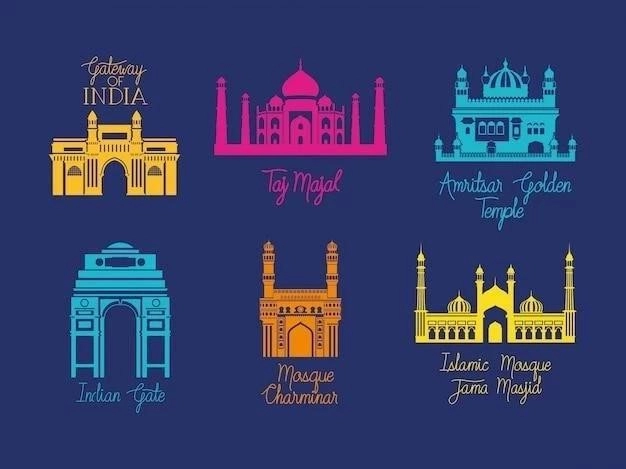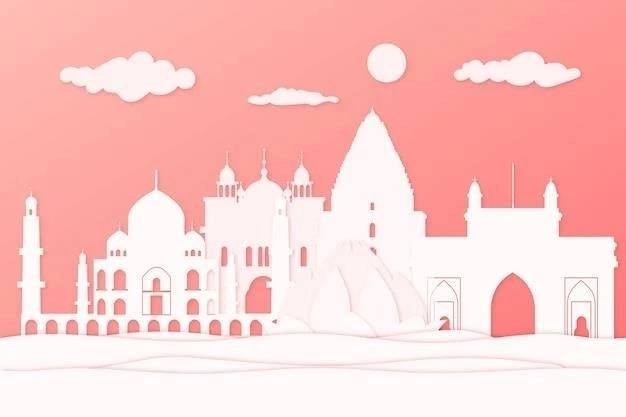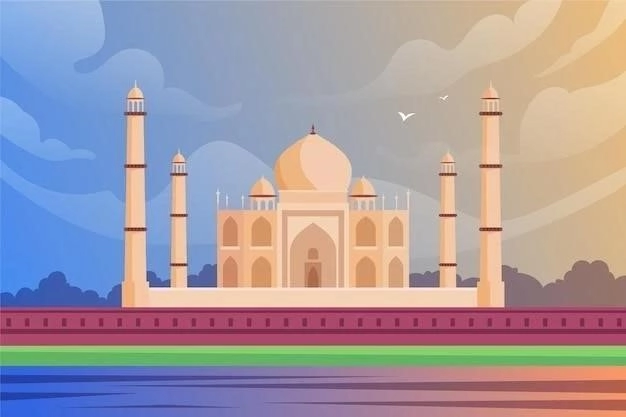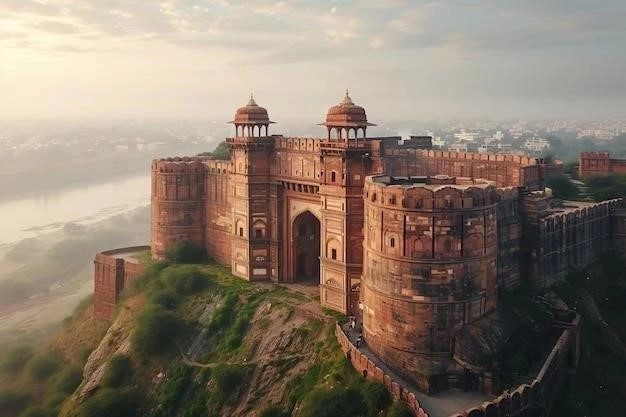The Red Fort‚ or Lal Qila in Hindi‚ stands as a majestic testament to Mughal architectural prowess and a poignant symbol of Indias rich history. Located in the heart of Old Delhi‚ this UNESCO World Heritage Site draws visitors from across the globe‚ captivating them with its intricate designs‚ imposing red sandstone walls‚ and the captivating stories whispered within its walls.
A History Etched in Stone
Commissioned in 1639 by the Mughal Emperor Shah Jahan‚ the Red Forts construction marked a pivotal moment in Indian history. Shah Jahan‚ renowned for his refined taste and ambition‚ sought to shift his capital from Agra to Delhi‚ envisioning a city that would surpass all others in splendor. The Red Fort‚ designed to be the epicenter of this new capital‚ Shahjahanabad‚ took nearly a decade to complete‚ finally reaching its full glory in 1648.
The forts history‚ however‚ extends beyond its grand beginnings. It served as the seat of Mughal power for over 200 years‚ witnessing the reigns of successive emperors‚ each leaving their own mark on its legacy. In 1739‚ the fort fell victim to the invading Persian forces led by Nader Shah‚ who looted its treasures‚ including the legendary Peacock Throne. The Mughal Empires decline in the 18th century led to the forts capture by the Marathas and later‚ the British‚ who used it as a garrison and made significant alterations to its structure.
Despite the trials it faced‚ the Red Fort remained a potent symbol. It was from its ramparts that the first Prime Minister of independent India‚ Jawaharlal Nehru‚ raised the Indian national flag on August 15‚ 1947‚ marking the end of British rule and the dawn of a new era for India. This tradition continues to this day‚ with the Prime Minister addressing the nation from the Red Fort on Independence Day‚ solidifying its position as a symbol of Indian sovereignty and pride.

An Architectural Symphony
The Red Forts architectural vocabulary is a harmonious blend of Persian‚ Timurid‚ and Hindu traditions‚ reflecting the Mughal Empires cosmopolitan nature and its assimilation of diverse cultural influences. The forts most striking feature is undoubtedly its massive enclosing walls‚ constructed from red sandstone‚ which lend the structure its distinctive name; These walls‚ rising to an imposing height of 33 meters and spanning over 2.5 kilometers‚ were not merely defensive barriers but also served as a canvas for intricate embellishments.
Within the forts walls lies a complex network of palaces‚ gardens‚ mosques‚ and audience halls‚ each a masterpiece in its own right. Some of the most notable structures include:
- Diwan-i-Am: The Hall of Public Audience‚ where the emperor would receive his subjects and dispense justice. It is famed for its elaborately carved sandstone balcony‚ known as the Jharokha‚ from which the emperor would address the gathered crowd.
- Diwan-i-Khas: The Hall of Private Audience‚ a more intimate space reserved for receiving important dignitaries and courtiers. It was originally adorned with the legendary Peacock Throne‚ a symbol of Mughal opulence.
- Rang Mahal: The Palace of Colors‚ named for its once vibrant interior decorations. This was the residence of the emperors wives and concubines.
- Moti Masjid: The Pearl Mosque‚ a stunning white marble mosque built by Aurangzeb‚ Shah Jahans son‚ for his personal use. Its simple elegance contrasts with the grandeur of the surrounding structures.
- Hayat Bakhsh Bagh: The Life-Giving Garden‚ a sprawling Mughal garden divided into four sections by waterways‚ representing the four rivers of paradise mentioned in the Quran.
The Red Forts layout follows a hierarchical pattern‚ with public areas located at the forefront‚ gradually leading to more private spaces‚ reflecting the Mughal courts structure and protocols. The use of water channels‚ fountains‚ and gardens was not merely ornamental but also served to cool the air and create a sense of tranquility amidst the bustling city.

The Red Fort Today
Today‚ the Red Fort stands as a powerful reminder of Indias Mughal past and its journey to independence. It is a site of national pride and a major tourist attraction‚ drawing millions of visitors annually. The fort houses several museums showcasing Mughal artifacts‚ paintings‚ and weaponry‚ offering a glimpse into the empires splendor and sophistication. Every year on Independence Day‚ the Indian Prime Minister hoists the national flag at the Red Forts main gate‚ followed by a speech broadcast nationwide‚ making it an integral part of Indias contemporary identity.
The Red Forts enduring legacy lies not just in its architectural magnificence but also in its representation of a pivotal era in Indian history. It stands as a testament to the Mughal Empires grandeur‚ its cultural syncretism‚ and its enduring impact on Indias artistic and architectural heritage. As a UNESCO World Heritage Site‚ the Red Fort continues to inspire awe and wonder‚ offering a window into a glorious past and serving as a symbol of national pride for generations to come.

Challenges and Conservation Efforts
Despite its historical significance and architectural grandeur‚ the Red Fort faces numerous challenges. Centuries of exposure to the elements‚ pollution‚ and urbanization have taken a toll on its structure. Overcrowding‚ vandalism‚ and inadequate maintenance have further exacerbated the situation‚ posing a threat to the forts long-term preservation.
Recognizing the urgency of the situation‚ the Archaeological Survey of India (ASI)‚ along with other governmental and non-governmental organizations‚ have undertaken various conservation and restoration projects. These efforts involve structural repairs‚ cleaning and restoration of the red sandstone‚ conservation of murals and artworks‚ and implementation of crowd management strategies.
However‚ conservation efforts extend beyond physical restoration. Educating the public‚ particularly younger generations‚ about the forts historical and cultural significance is crucial for fostering a sense of ownership and responsibility. Initiatives such as guided tours‚ educational programs‚ and interactive exhibits aim to create a deeper understanding and appreciation for this invaluable heritage site.

The Red Fort in the 21st Century: Balancing Preservation and Progress
The Red Fort stands at a crossroads‚ navigating the complexities of preserving a historical monument in the face of a rapidly developing urban landscape. Balancing the demands of tourism‚ conservation‚ and development is a continuous process. Sustainable tourism practices‚ such as limiting visitor numbers‚ promoting responsible behavior‚ and investing in infrastructure upgrades‚ are essential for mitigating the impact of tourism on the forts delicate ecosystem.
Moreover‚ integrating the Red Fort with the surrounding urban fabric is crucial for its long-term viability. Creating pedestrian-friendly zones‚ improving public transportation‚ and developing heritage trails that connect the fort to other historical sites in Old Delhi can enhance the visitor experience while minimizing vehicular traffic and pollution.
The Red Forts story is far from over. It continues to evolve‚ adapting to the challenges and opportunities of the 21st century. By embracing a holistic approach to conservation‚ incorporating sustainable practices‚ and fostering community engagement‚ the Red Fort can continue to inspire awe and wonder‚ serving as a beacon of Indias rich heritage for generations to come.










